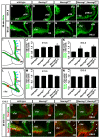Neurog1 and Neurog2 coordinately regulate development of the olfactory system
- PMID: 22906231
- PMCID: PMC3444899
- DOI: 10.1186/1749-8104-7-28
Neurog1 and Neurog2 coordinately regulate development of the olfactory system
Abstract
Background: Proneural genes encode basic helix-loop-helix transcription factors that specify distinct neuronal identities in different regions of the nervous system. In the embryonic telencephalon, the proneural genes Neurog1 and Neurog2 specify a dorsal regional identity and glutamatergic projection neuron phenotype in the presumptive neocortex, but their roles in cell fate specification in the olfactory bulb, which is also partly derived from dorsal telencephalic progenitors, have yet to be assessed. Given that olfactory bulb development is guided by interactions with the olfactory epithelium in the periphery, where proneural genes are also expressed, we investigated the roles of Neurog1 and Neurog2 in the coordinated development of these two olfactory structures.
Results: Neurog1/2 are co-expressed in olfactory bulb progenitors, while only Neurog1 is widely expressed in progenitors for olfactory sensory neurons in the olfactory epithelium. Strikingly, only a remnant of an olfactory bulb forms in Neurog1-/-;Neurog2-/- double mutants, while this structure is smaller but distinguishable in Neurog1-/- single mutants and morphologically normal in Neurog2-/- single mutants. At the cellular level, fewer glutamatergic mitral and juxtaglomerular cells differentiate in Neurog1-/-;Neurog2-/- double-mutant olfactory bulbs. Instead, ectopic olfactory bulb interneurons are derived from dorsal telencephalic lineages in Neurog1-/-;Neurog2-/- double mutants and to a lesser extent in Neurog2-/- single mutants. Conversely, cell fate specification is normal in Neurog1-/- olfactory bulbs, but aberrant patterns of cell proliferation and neuronal migration are observed in Neurog1-/- single and Neurog1-/-;Neurog2-/- double mutants, probably contributing to their altered morphologies. Finally, in Neurog1-/- and Neurog1-/-;Neurog2-/- embryos, olfactory sensory neurons in the epithelium, which normally project to the olfactory bulb to guide its morphogenesis, fail to innervate the olfactory bulb.
Conclusions: We have identified a cell autonomous role for Neurog1/2 in specifying the glutamatergic identity of olfactory bulb neurons. Furthermore, Neurog1 (and not Neurog2) is required to guide olfactory sensory neuron innervation of the olfactory bulb, the loss of which results in defects in olfactory bulb proliferation and tissue morphogenesis. We thus conclude that Neurog1/2 together coordinate development of the olfactory system, which depends on tissue interactions between the olfactory bulb and epithelium.
Figures










Similar articles
-
Neurog1 and Neurog2 control two waves of neuronal differentiation in the piriform cortex.J Neurosci. 2014 Jan 8;34(2):539-53. doi: 10.1523/JNEUROSCI.0614-13.2014. J Neurosci. 2014. PMID: 24403153 Free PMC article.
-
A non-canonical role for the proneural gene Neurog1 as a negative regulator of neocortical neurogenesis.Development. 2018 Oct 1;145(19):dev157719. doi: 10.1242/dev.157719. Development. 2018. PMID: 30201687 Free PMC article.
-
DLX5 regulates development of peripheral and central components of the olfactory system.J Neurosci. 2003 Jan 15;23(2):568-78. doi: 10.1523/JNEUROSCI.23-02-00568.2003. J Neurosci. 2003. PMID: 12533617 Free PMC article.
-
Proneural genes in neocortical development.Neuroscience. 2013 Dec 3;253:256-73. doi: 10.1016/j.neuroscience.2013.08.029. Epub 2013 Aug 30. Neuroscience. 2013. PMID: 23999125 Review.
-
Instructing neuronal identity during CNS development and astroglial-lineage reprogramming: Roles of NEUROG2 and ASCL1.Brain Res. 2019 Feb 15;1705:66-74. doi: 10.1016/j.brainres.2018.02.045. Epub 2018 Mar 3. Brain Res. 2019. PMID: 29510143 Review.
Cited by
-
Suppression of BMP signaling restores mitral cell development impaired by FGF signaling deficits in mouse olfactory bulb.Mol Cell Neurosci. 2024 Mar;128:103913. doi: 10.1016/j.mcn.2023.103913. Epub 2023 Dec 5. Mol Cell Neurosci. 2024. PMID: 38056728 Free PMC article.
-
Deciphering the Transcriptional Landscape of Human Pluripotent Stem Cell-Derived GnRH Neurons: The Role of Wnt Signaling in Patterning the Neural Fate.Stem Cells. 2022 Dec 31;40(12):1107-1121. doi: 10.1093/stmcls/sxac069. Stem Cells. 2022. PMID: 36153707 Free PMC article.
-
A chronological expression profile of gene activity during embryonic mouse brain development.Mamm Genome. 2013 Dec;24(11-12):459-72. doi: 10.1007/s00335-013-9486-7. Epub 2013 Nov 19. Mamm Genome. 2013. PMID: 24249052 Free PMC article.
-
Determination of the connectivity of newborn neurons in mammalian olfactory circuits.Cell Mol Life Sci. 2017 Mar;74(5):849-867. doi: 10.1007/s00018-016-2367-y. Epub 2016 Sep 30. Cell Mol Life Sci. 2017. PMID: 27695873 Free PMC article. Review.
-
mSWI/SNF (BAF) Complexes Are Indispensable for the Neurogenesis and Development of Embryonic Olfactory Epithelium.PLoS Genet. 2016 Sep 9;12(9):e1006274. doi: 10.1371/journal.pgen.1006274. eCollection 2016 Sep. PLoS Genet. 2016. PMID: 27611684 Free PMC article.
References
-
- Bayer SA. 3H-thymidine-radiographic studies of neurogenesis in the rat olfactory bulb. Exp Brain Res. 1983;50:329–340. - PubMed
-
- Wichterle H, Turnbull DH, Nery S, Fishell G, Alvarez-Buylla A. In utero fate mapping reveals distinct migratory pathways and fates of neurons born in the mammalian basal forebrain. Development. 2001;128:3759–3771. - PubMed
Publication types
MeSH terms
Substances
Grants and funding
LinkOut - more resources
Full Text Sources
Molecular Biology Databases

